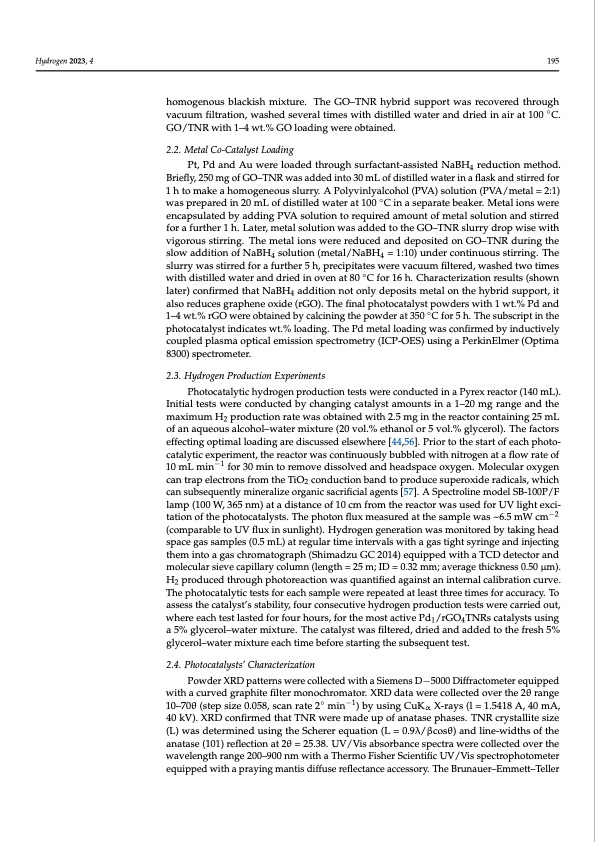
PDF Publication Title:
Text from PDF Page: 004
Hydrogen 2023, 4 195 homogenous blackish mixture. The GO–TNR hybrid support was recovered through vacuum filtration, washed several times with distilled water and dried in air at 100 ◦C. GO/TNR with 1–4 wt.% GO loading were obtained. 2.2. Metal Co-Catalyst Loading Pt, Pd and Au were loaded through surfactant-assisted NaBH4 reduction method. Briefly, 250 mg of GO–TNR was added into 30 mL of distilled water in a flask and stirred for 1 h to make a homogeneous slurry. A Polyvinlyalcohol (PVA) solution (PVA/metal = 2:1) was prepared in 20 mL of distilled water at 100 ◦C in a separate beaker. Metal ions were encapsulated by adding PVA solution to required amount of metal solution and stirred for a further 1 h. Later, metal solution was added to the GO–TNR slurry drop wise with vigorous stirring. The metal ions were reduced and deposited on GO–TNR during the slow addition of NaBH4 solution (metal/NaBH4 = 1:10) under continuous stirring. The slurry was stirred for a further 5 h, precipitates were vacuum filtered, washed two times with distilled water and dried in oven at 80 ◦C for 16 h. Characterization results (shown later) confirmed that NaBH4 addition not only deposits metal on the hybrid support, it also reduces graphene oxide (rGO). The final photocatalyst powders with 1 wt.% Pd and 1–4 wt.% rGO were obtained by calcining the powder at 350 ◦C for 5 h. The subscript in the photocatalyst indicates wt.% loading. The Pd metal loading was confirmed by inductively coupled plasma optical emission spectrometry (ICP-OES) using a PerkinElmer (Optima 8300) spectrometer. 2.3. Hydrogen Production Experiments Photocatalytic hydrogen production tests were conducted in a Pyrex reactor (140 mL). Initial tests were conducted by changing catalyst amounts in a 1–20 mg range and the maximum H2 production rate was obtained with 2.5 mg in the reactor containing 25 mL of an aqueous alcohol–water mixture (20 vol.% ethanol or 5 vol.% glycerol). The factors effecting optimal loading are discussed elsewhere [44,56]. Prior to the start of each photo- catalytic experiment, the reactor was continuously bubbled with nitrogen at a flow rate of 10 mL min−1 for 30 min to remove dissolved and headspace oxygen. Molecular oxygen can trap electrons from the TiO2 conduction band to produce superoxide radicals, which can subsequently mineralize organic sacrificial agents [57]. A Spectroline model SB-100P/F lamp (100 W, 365 nm) at a distance of 10 cm from the reactor was used for UV light exci- tation of the photocatalysts. The photon flux measured at the sample was ~6.5 mW cm−2 (comparable to UV flux in sunlight). Hydrogen generation was monitored by taking head space gas samples (0.5 mL) at regular time intervals with a gas tight syringe and injecting them into a gas chromatograph (Shimadzu GC 2014) equipped with a TCD detector and molecular sieve capillary column (length = 25 m; ID = 0.32 mm; average thickness 0.50 μm). H2 produced through photoreaction was quantified against an internal calibration curve. The photocatalytic tests for each sample were repeated at least three times for accuracy. To assess the catalyst’s stability, four consecutive hydrogen production tests were carried out, where each test lasted for four hours, for the most active Pd1/rGO4TNRs catalysts using a 5% glycerol–water mixture. The catalyst was filtered, dried and added to the fresh 5% glycerol–water mixture each time before starting the subsequent test. 2.4. Photocatalysts’ Characterization Powder XRD patterns were collected with a Siemens D−5000 Diffractometer equipped with a curved graphite filter monochromator. XRD data were collected over the 2θ range 10–70θ (step size 0.058, scan rate 2◦ min−1) by using CuKα X-rays (l = 1.5418 A, 40 mA, 40 kV). XRD confirmed that TNR were made up of anatase phases. TNR crystallite size (L) was determined using the Scherer equation (L = 0.9λ/βcosθ) and line-widths of the anatase (101) reflection at 2θ = 25.38. UV/Vis absorbance spectra were collected over the wavelength range 200–900 nm with a Thermo Fisher Scientific UV/Vis spectrophotometer equipped with a praying mantis diffuse reflectance accessory. The Brunauer–Emmett–TellerPDF Image | Enhanced Photoreforming of Oxygenates

PDF Search Title:
Enhanced Photoreforming of OxygenatesOriginal File Name Searched:
hydrogen-04-00014-v2.pdfDIY PDF Search: Google It | Yahoo | Bing
Salgenx Redox Flow Battery Technology: Power up your energy storage game with Salgenx Salt Water Battery. With its advanced technology, the flow battery provides reliable, scalable, and sustainable energy storage for utility-scale projects. Upgrade to a Salgenx flow battery today and take control of your energy future.
| CONTACT TEL: 608-238-6001 Email: greg@infinityturbine.com | RSS | AMP |